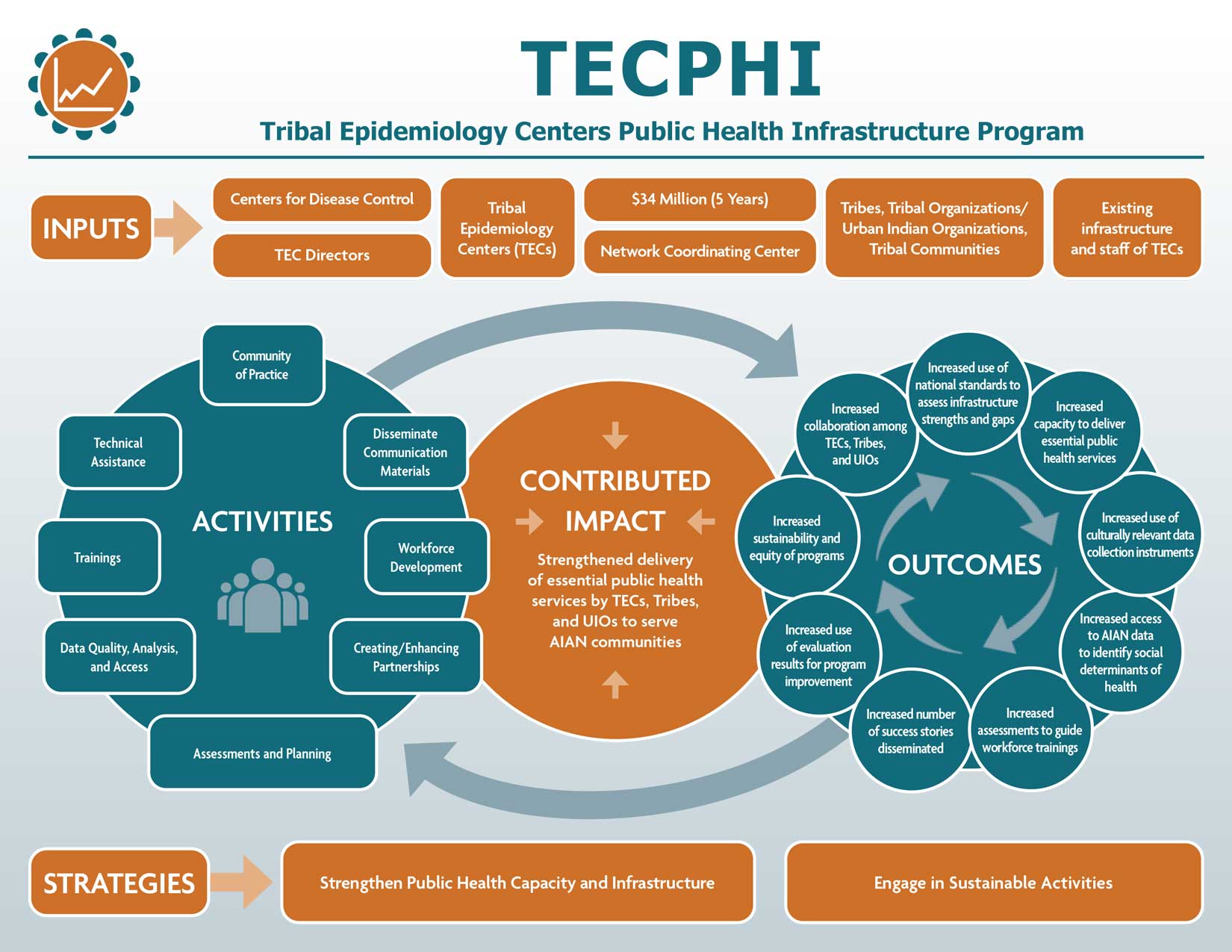With input from a Tribal advisory committee, the CDC designed TECPHI to supplement the 12 Tribal Epidemiology Centers (TECs) to strengthen public health infrastructure and capacity, improve health by identifying and addressing health risks, and support disease prevention and control.12
What does TECPHI do?
Although each TEC’s project is unique, they are all engaging in the following key strategies to contribute to overall health for AI/AN people nationwide:
– Strengthen public health capacity and infrastructure;
– Implement activities to improve the effectiveness of health promotion and disease prevention;
– Collaborate with Tribal and other partners to achieve collective action; and
– Engage in sustainability activities.

What is a TEC? Download the Handout (PDF 792 KB)
12Reece, J., Skelton-Wilson, S., Mitchell-Box, K., Groom, A., & Thomas, C. (2023). Building a roadmap to health equity: strengthening public health infrastructure in Indian Country. Public Health Reports, 00333549231186579.
The TECPHI Model
To learn more about the TECPHI Model, please refer to Reece J, Skelton-Wilson S, Mitchell-Box K, Groom A, Thomas C. Building a Roadmap to Health Equity: Strengthening Public Health Infrastructure in Indian Country. Public Health Reports®. 2023;138(2_suppl):7S-13S. doi:10.1177/00333549231186579
TECPHI Program Logic Model (PDF 110 KB)
- Collecting data and monitoring health;
- evaluating data and programs;
- identifying health priorities;
- making recommendations for health service needs;
- making recommendations for improving health care delivery systems;
- providing epidemiologic and other technical assistance; and
- providing disease surveillance.
- a workforce trained in public health core competencies;
- an information and data systems to rapidly analyze, assess, and communicate information;
- an ability to respond in a culturally relevant way to AI/AN public health needs; and
- an established plan to sustain a program’s efforts once funding has ended.
- maintain core program components and activities consistent with goals and objectives;
- respond and adapt to AI/AN public health needs; and
- provide continued benefits and value to those they serve.
TECs and the 10 Essential Public Health Services
TECs work across all 10 EPHS to support T/TO/UIOs and Tribal communities (Figure 2). TEC work is essential for developing policies and systems and understanding overall community conditions to make progress in achieving optimal health for all. TEC activities are aligned with the 10 EPHS to demonstrate the unique and important role of the TECs in the public health system and in supporting the health and wellbeing of T/TO/UIOs and Tribal communities.
TECPHI 2.0
Year 1 Progress Report (PDF 7 MB)
Executive Summary (PDF 591 KB)
Key Messages (PDF 452 KB)
Supplements:
Communications (PDF 677 KB)
Evaluation (PDF 2 MB)
Workforce Development (PDF 751 KB)
TECPHI 1.0
Year 1 Progress Report (PDF 7 MB)
Year 1 Photo Narrative (PDF 6 MB)
Year 2 Progress Report (PDF 2 MB)
Year 2 Photo Narrative (PDF 9 MB)
Year 3 Progress Report (PDF 4 MB)
Year 3 Photo Narrative (PDF 8 MB)
Year 3 Qualitative Projects (PDF 6 MB)
TECPHI Year Final Brief Report (PDF 925 KB)
TECPHI Year 4 & 5 Progress Report (PDF 2 MB)
TECPHI Year 4 Photo Narrative (PDF 5 MB)
TECPHI Year 5 Photo Narrative (PDF 4 MB)
TECPHI Year 4 Qualitative Projects (PDF 5 MB)
TECPHI Year 5 Qualitative Projects (PDF 2 MB)
TECPHI Brochure/Inserts (PDF 2 MB)
For a full print-friendly description of the TECPHI program, click here to download a PDF (8.6MB)
(Print as a booklet for best results).
Visit CDC’s TECPHI page here: https://www.cdc.gov/healthy-tribes-tecphi/php/about/


